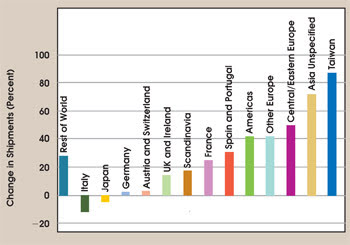Anne L. Fischer, Senior Editor
The European Machine Vision Association in Frankfurt, Germany, recently released a report on the machine vision market in Europe, while the German Manufacturing Federation released a complementary report for just that country. Not surprisingly, the statistics in the two documents nearly parallel each other, but the differences illustrate the strength and importance of German companies in this field.
European Vision Technology Market Statistics 2005 describes which industries use which vision products and in what applications. Overall, the turnover for machine vision products has developed throughout the world, with exports up everywhere from 2003 to 2004, with the exception of those to Japan, Austria and Switzerland.

The European machine vision market remains vibrant, as shown by exports of machine vision products, which exhibited growth to most countries and regions of the world from 2003 to 2004.
This does not mean, however, that sales to these countries declined, said Patrick Schwarzkopf, general secretary of the association. Overall turnover increased by 16 percent, but turnover to Austria and Switzerland rose by only 3 percent. Similarly, the shipments from European vision companies to Japan fell from a share of the total of 3.3 percent to 2.7 percent, but Schwarzkopf said that this could be attributed to some big orders that were placed last year, indicating that the drop in turnover was slight.
Nonmanufacturing industries are the largest purchasers of machine vision products at 25 percent, with automotive coming in second at 18 percent and electrical/electronics, third at 13 percent. The applications for which vision systems were purchased by the automotive industry in 2004 were led by inspection at 60 percent, with guidance coming in at 19 percent and metrology following at 17 percent.
The breakdown of the types of products sold in 2004 shows that 64 percent were vision systems and that 36 percent were vision components. Of the component sector, cameras were the leading product sold at 23 percent, and just over a quarter of those were sold to the electrical/electronics industries.
German survey
The German report is the result of the federation’s machine vision market survey, from which the feedback from 40 companies was evaluated. It includes the development of industry turnover, the number of employees, and market share by type of business and component.
The machine vision industry in Germany has done very well since 1995, even when the economy did poorly. Schwarzkopf explained that this is because it is an enabling technology: increasing quality, raising productivity and cutting costs. He said that it remains important in downtimes to tackle these problems.
In 2004, the industry in Germany grew 14 percent, exceeding the forecast of 10 percent. Takeovers and mergers, as well as industry growth, are attributed to the expansion of machine vision companies in the country, and the report indicates that, although the number of these companies that have employees abroad is still small, this will change as exports continue to increase.
Sales of individual vision components set the German industry apart from others in Europe. Although camera sales were similar to those in Europe, optical components made up 12 percent of the German market, compared with 7 percent in Europe. The report attributes a decline in sales of frame grabbers since 2002 to the trend toward the use of digital cameras.
The report concludes that the machine vision industry in Europe remains vibrant and growing despite fierce global competition. The federation’s findings are contained within the European Vision Technology Market Statistics report, which sells for h1200 to nonmembers and for h980 to members and which is available at www.emva.org.